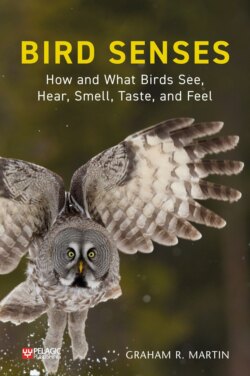Читать книгу Bird Senses - Graham R. Martin - Страница 22
На сайте Литреса книга снята с продажи.
Sensory thresholds
ОглавлениеLimits of sensory performance are defined as absolute thresholds. These are measures of the minimum amount of a particular stimulus that can be detected. In the case of sound, this will be the smallest amount of air disturbance that the hearing system can detect. In vision, it is the lowest number of photons received per unit time that can be detected. In the chemical senses (taste and olfaction), it is the lowest concentration of molecules of a particular substance that can be detected. In mechanical senses (for example, touch sensitivity of a bird’s bill) it is the smallest displacement of the detecting surface.
Absolute thresholds are particularly interesting because they allow simple and direct questions to be posed. Which species has the most sensitive hearing? Which species has the most sensitive eyes? However, comparing thresholds is not as straightforward as one might hope, and answers are rarely clear-cut. This is because thresholds differ not just between species but between individuals.
Like all measures of performance, absolute sensory thresholds tend to be normally distributed when the results for individuals are collected together. This means that the absolute threshold for a species is best described statistically as a mean value with variation around it based on a sample of individuals. Between-individual differences are often particularly notable if age comes into play. A change in sensitivity is usually part of the ageing process in birds, as much as in humans. Therefore, to compare species it is necessary to refer to mean differences, and to be aware that individuals will have sensitivities below or above this mean.
A simple analogy is to consider what the answer might be if you asked how fast humans can run. Every able-bodied person can run, but there is no surprise that the running speeds of people will differ, often markedly so. The answer is that there will be a mean speed for human running performance but around the mean there will be a wide range of speeds. It would then make sense to compare the average running speeds of humans with another animal species, and while there might be a difference in the averages there may well be some overlap in the performances of individuals of the two species.
It is the same with absolute sensory thresholds: differences between individuals do occur. Also, an individual’s thresholds can change owing to a range of factors, including their motivation to participate in the investigation. So, although absolute thresholds are both important and interesting, and will feature a number of times in this book, it will always be necessary to express caution, or at least bear in mind that sensory thresholds are mean values based on a sample of individuals representing a particular species.
